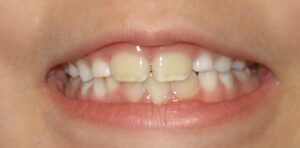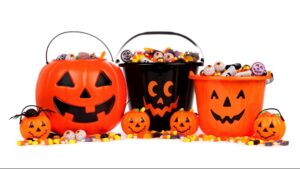December 7th, 2020

As children start losing their baby teeth and their new adult teeth come in, a lot of parents ask, "why are their new teeth yellow?" and "is this something we should be worried about?" These are great questions! First off, this is definitely nothing to worry about! Adult teeth are naturally more yellow in color than baby teeth, and here are the reasons why:
- Every tooth is made up of layers: an outer 'white' layer (enamel), an inner 'yellow' layer (dentin), and the innermost layer containing blood vessels and nerves (pulp). Baby teeth and adult teeth look different based on the amount of thickness of the layers of enamel and dentin!
- Baby teeth have thin layers of dentin, meaning less of the 'yellow' layer. The enamel in baby teeth is also more opaque, making it harder to see the yellow layer through the white. All of this together makes baby teeth look super bright and white!
- Adult teeth have a thicker dentin layer, meaning more 'yellow.' The enamel is also semi-translucent, allowing the yellow color underneath to show through more easily. This allows adult teeth to be more yellow in color.
One last question you may have is: "can we do anything about the yellow teeth?"
- We don't recommend teeth whitening in office or at home whitening kits for young children. These products can make teeth extremely sensitive and uncomfortable for your child.
- Also, if your child has a mixture of baby teeth and adult teeth currently in the mouth, there are still more adult teeth to come in to replace those baby teeth. If you choose to whiten teeth at this time, the new set of adult teeth coming in will be a different color - you won't be able to specifically whiten the new teeth to match the old ones!
- Once a child has all of their adult teeth in their late teenage years, we can go over different safe methods of whitening their teeth to reduce the chances of sensitivity and to keep their teeth healthy.
So are yellow teeth bad? Not at all! We always want to emphasize the importance of strong and healthy teeth is by not having any cavities - not the color of the teeth. Having white teeth doesn't always mean a tooth is healthy!
October 28th, 2020

What greater way to celebrate Halloween than with tasty and healthy snacks? This is a fun recipe to do with your child that's interactive and yummy!
Monster Apple Bites
Ingredients
- 2 Apples - any color of your choice! (We chose green apples).
- 1/4 cup of nut butter - any butter of your choice if your child is allergic to nuts! (We chose peanut butter).
- 1/4 cup of seeds - any seed of your choice that look like teeth! (We chose pumpkin seeds, but you can also use sunflower seeds).
- 2-3 strawberries
- Handful of sugar googly eyes - these are available for purchase from the bakery aisle
Steps
- Quarter each apple to create the monster. Cut the middle out of the slice to create a mouth - doesn't need to be perfect because you'll be filling in the gap with your nut butter!
- Coat the inside of the "mouth" with the nut butter.
- Place seeds along the top of the "mouth" to make teeth.
- Place 1 sliced strawberry inside of the "mouth" to create a tongue.
- Dab each googly eye with a bit of nut butter to stick the eyes to the apple slice.
- Ta-da! Monster apples!
Hope this brings your child happy smiles on Halloween!
October 15th, 2020

You may not know, but dentists can have a sweet tooth too! We love sweets just as much as you do, so with Halloween coming up, we wanted to give you tips on how to continue to take care of your teeth during this sugary holiday!
Candy that are "tooth-friendly" are candy that quickly leave the mouth and are not sticky! Chocolate is the best "tooth-friendly" type of sweet! It enters the mouth and leaves the teeth really fast as it melts away.
Candy that are not as "tooth-friendly" are candy that are sticky. These types of candy stay in the mouth for a long time! They stick really tight to the chewing surfaces of teeth and can potentially cause cavities. We want to avoid too much of gummy bears, gummy worms, taffy, and caramels.
The most important thing is to eat sweets in moderation. Keep your child's candy in a place that is not visible. Having candy out in the open and easily accessible will increase the amount of times your child will want to have that candy. Also, give candy as a special treat, not as a type of food they eat on a daily basis.
And of course, don't forget to brush your child's teeth! Remember to brush two times a day, two minutes each time.
We hope everyone has a safe and healthy Halloween, and keep your teeth shiny and clean!
September 23rd, 2020
With sports resuming, we wanted to turn our attention to a topic that's not discussed as often - Mouthguards! What are mouthguards you may ask? These are also known as mouth protectors because they help cushion any injury to the face. Wearing a mouthguard minimizes the risk of broken teeth and injury to lips, tongue, face, and jaw. The teeth we are most concerned about are the upper front teeth. The lower teeth are more protected because they are further back, but your upper teeth are front and center to any injury to the face! Lost of your child's front teeth may affect the way they smile, talk, and eat. By preventing these injuries, we can protect your child's beautiful smile!
A mouthguard should be worn as part of the athletic gear of the sport that they play. Did you know that dental injury was most common during baseball in children aged 7-12 years and during basketball in children aged 13-17 years? These higher collision and contact sports increase the risk for injury!
The best type of mouthguard is one that is custom made for your child by a dentist. The mouthguard is made specifically from a mold of your child's mouth so that it fits nice and snug. You can also purchase a mouthguard from any drug store, known as a boil-and-bite mouthguard. These mouthguards are softened in boiled water, then inserted to your child's mouth to allow it to adapt to the shape of their mouth. They do not have the perfect fit of a custom mouthguard, but will still be able to protect your child's mouth! Lastly, there are stock mouthguards also found in drug stores that are inexpensive and come preformed and ready to wear. The only downside to this type of mouthguard is that they don't fit very well, may be bulky and makes breathing and talking very difficult.

In addition, if your child has braces, a mouthguard becomes even more important! Any injury to the face may not only cause damage to the teeth but also to the orthodontic appliances that may end up injurying your child's gums and cheeks.
You should always work with your dentist regarding choosing the right mouthguard for your child. As your child grows, they may need to switch mouthguards to adapt to the growth of their jaws! In addition, keeping their mouthguard clean is as important as brushing their teeth - we don't want any infections to start from bacteria growing inside the mouthguard.
Let's work together as a team to help maintain your child's smile!





